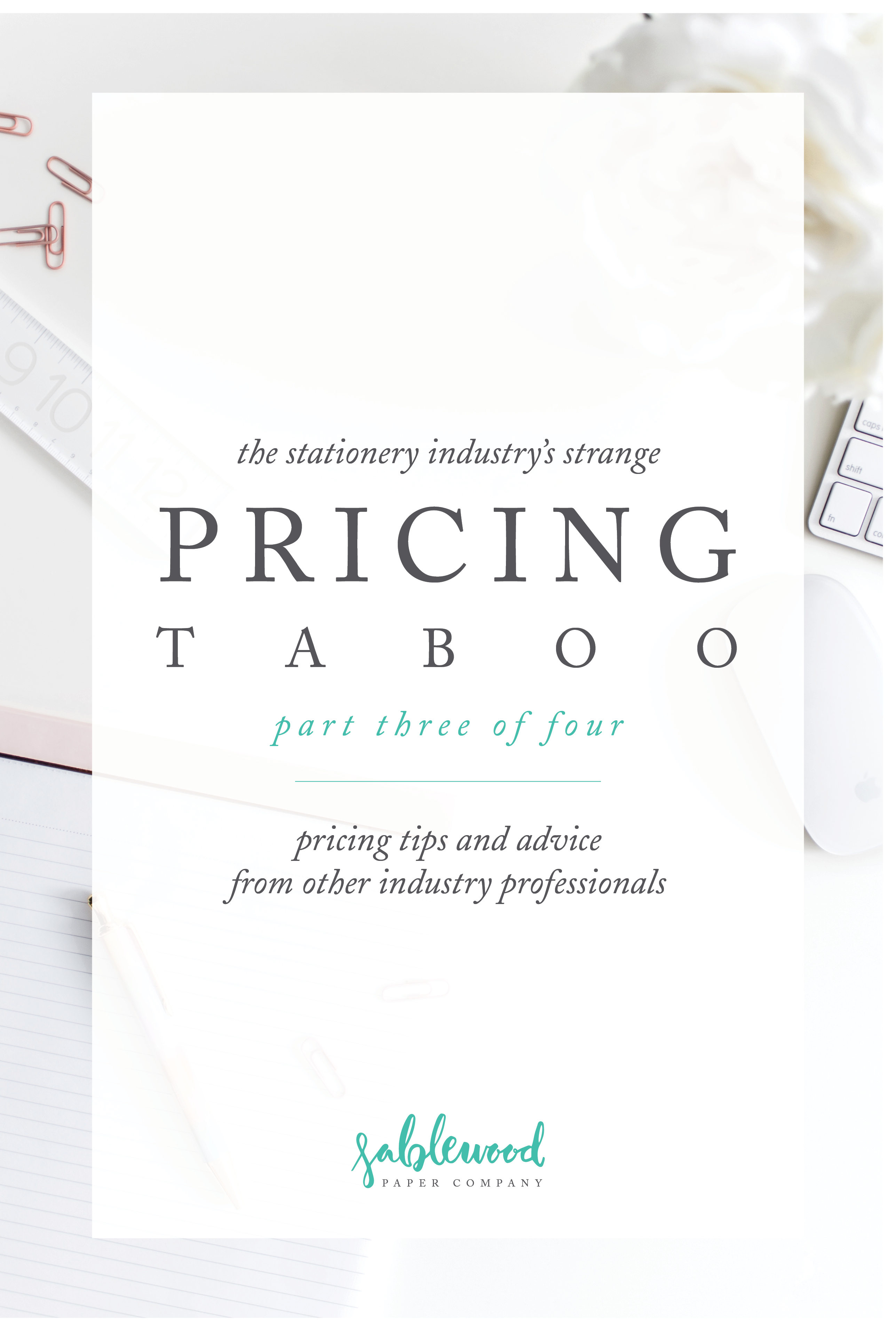
Now that we understand WHY it’s important to create industry standard pricing, how do other professionals price their work?
Well, this week I have a special treat for you: you’re going to hear from other calligraphers and stationers who have struggled with pricing and come out the other side! Everyone has amazing advice for you and I’m grateful to each of them for speaking up about their methods. As you can see, everyone does things a little differently…but every one of them have a solid pricing foundation.
Make sure to follow all of them to see their gorgeous creations!
- Dominique of Plume and Fête | @plumeandfete
- Tess of Little Duck Calligraphy | @littleduckcalligraphy
- Cami of Cami Monet Watercolor & Calligraphy | @camimonet
- Sarah of Sarah B. Calligraphy | @sarahbcalligraphy
So soak it all up, read it twice, bookmark…and don’t forget that we’re all in this industry for the same reason: because we love stationery and calligraphy.
And now, I’m passing the torch to these lovely ladies!
[hr]
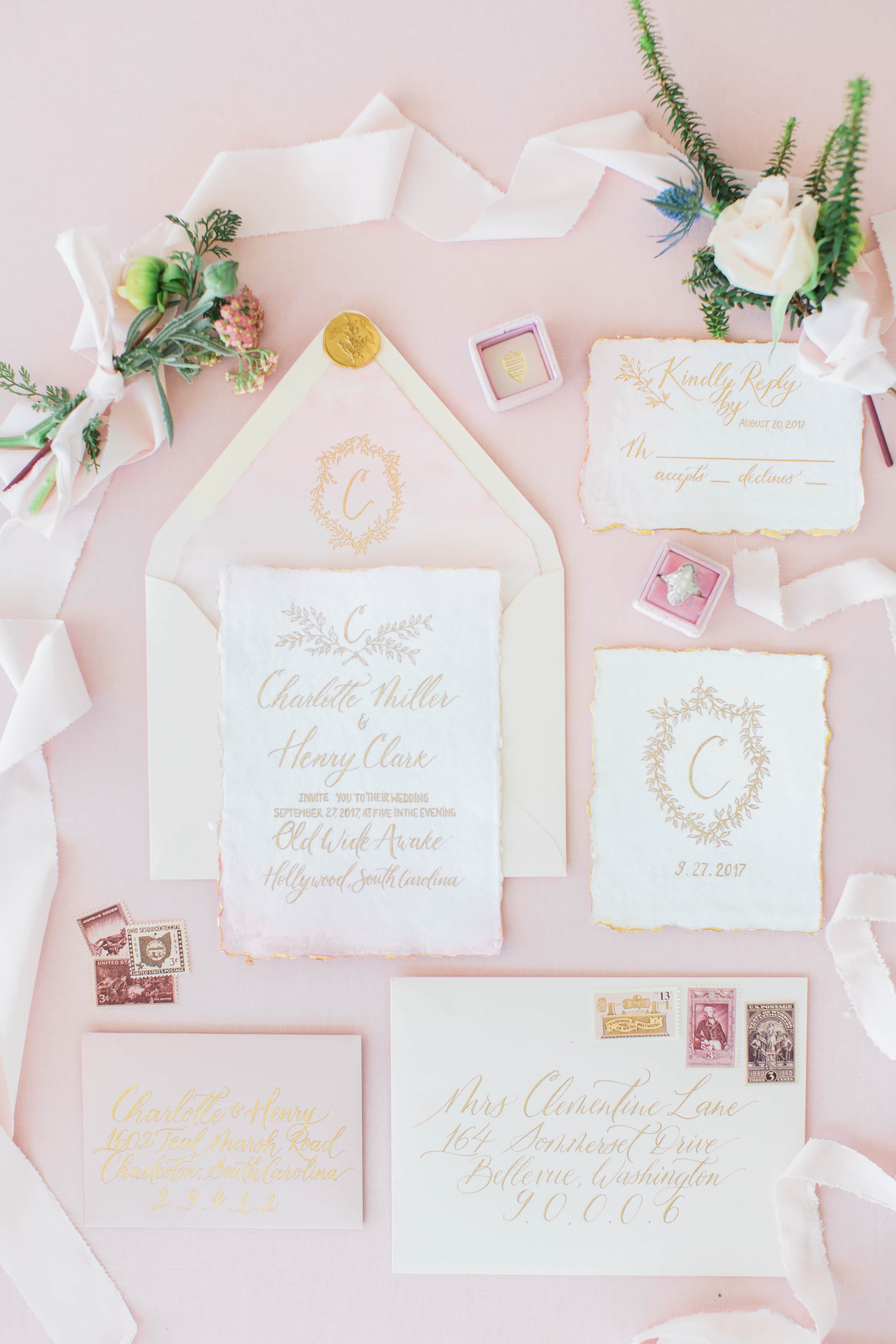
photo by Nicole Moore (@avamoorephotography)
Dominique, Plume & Fête
www.plumeandfete.com | @plumeandfete
I’m a strong believer that pricing shouldn’t be taboo, but an open, honest discussion. Talking about pricing makes our industry stronger, and it helps clients understand the value of custom. There is a lot that goes behind creating stationery or even just addressing envelopes. Years of courses, investments, tears and sweat go into creating each piece. This is a real job, no matter if you are doing it on the side or full time, and understanding this is the key to gain the respect of clients and even friends and family. If you have ever been asked to do free work for friends (I know you have!), remember that it wasn’t free for you! You invested materials, skills and time that you could be using to create paid work, and your friends and family should understand that and offer to pay full price (and it’s up to you to give them a discount or not).
If you are just starting out and are not sure of how to price your work, don’t pretend to be a client to find out other stationer’s rates. Ask for help, do some research and set prices that are tailored to your own level of skills, region and target market. There are niches inside of this niche that is custom stationery, and setting low prices will trap you into the wrong market – and repositioning is harder than adopting the right strategy from start. Here are some tips for figuring out your prices:
– Calculate all the costs of running your business in your city, from bills to equipments and basic materials. Even if this is not your full time job, figure out how much you need to make a year, and then divide that by the amount of hours you need to work (i.e. 40 a week). Double that to cover taxes and all the non-billable hours of work (such as time for marketing and accounting), and you will find your base hourly rate.
– Most stationers charge per project instead of per hour, but their hourly rate is used to calculate their design fees. Your design fee should cover all the hours you will spend on a project, from sketching to digitalizing and coordinating with printing companies, and also the time communicating with your client. You can start with a lower hourly rate (within that limit you have stipulated above), and then raise it as you gain expertise. That means you won’t have to charge less once you have years of experience and it takes you less time to complete the same job. Your rate will grow to match that.
– A simple way to estimate the price of a custom stationery project is to calculate all the specialty materials and printing costs involved, and then add the design fee on top of it, plus taxes and shipping/ handling. Everyone has a different method to calculate their prices, but this will give you a good notion if you are just starting out. For example, let’s say a bride requested a quote for 100 save the date cards, with spot calligraphy, typography and botanical illustrations, flat printed on A7 Cranes Lettra paper. Because I don’t print in-house (unless I don’t have another choice), I have pricing lists from my preferred printers. The wholesale printing cost of 100 flat printed cards is $90, but that doesn’t include shipping, fees and extras, so I add another 50% to make sure everything is covered (sometimes I’ll add more or less depending on where I’m printing and the costs involved). Now that I know my printing fee ($135), I calculate my design fee based on how long it would take me to design the piece. If my hourly rate is $60, and I know the whole process of sketching, designing, proofing and communicating with the client will take me about 7 hours, I can say that my design fee for this project is $420. Although I have to calculate both factors separately to find out the price, I only give the bride the final price – $555 for 100 save the date cards ($5.55 per card), plus shipping and taxes.
Pricing might be overwhelming at first, but charging a fair price for your work will help you feel confident and happy with it. Remember that you started your business because you were passionate about it, and the fastest way to turn your passion into something you dread is by feeling undervalued and overworked. And again, don’t be afraid of reaching out for help!
[hr]
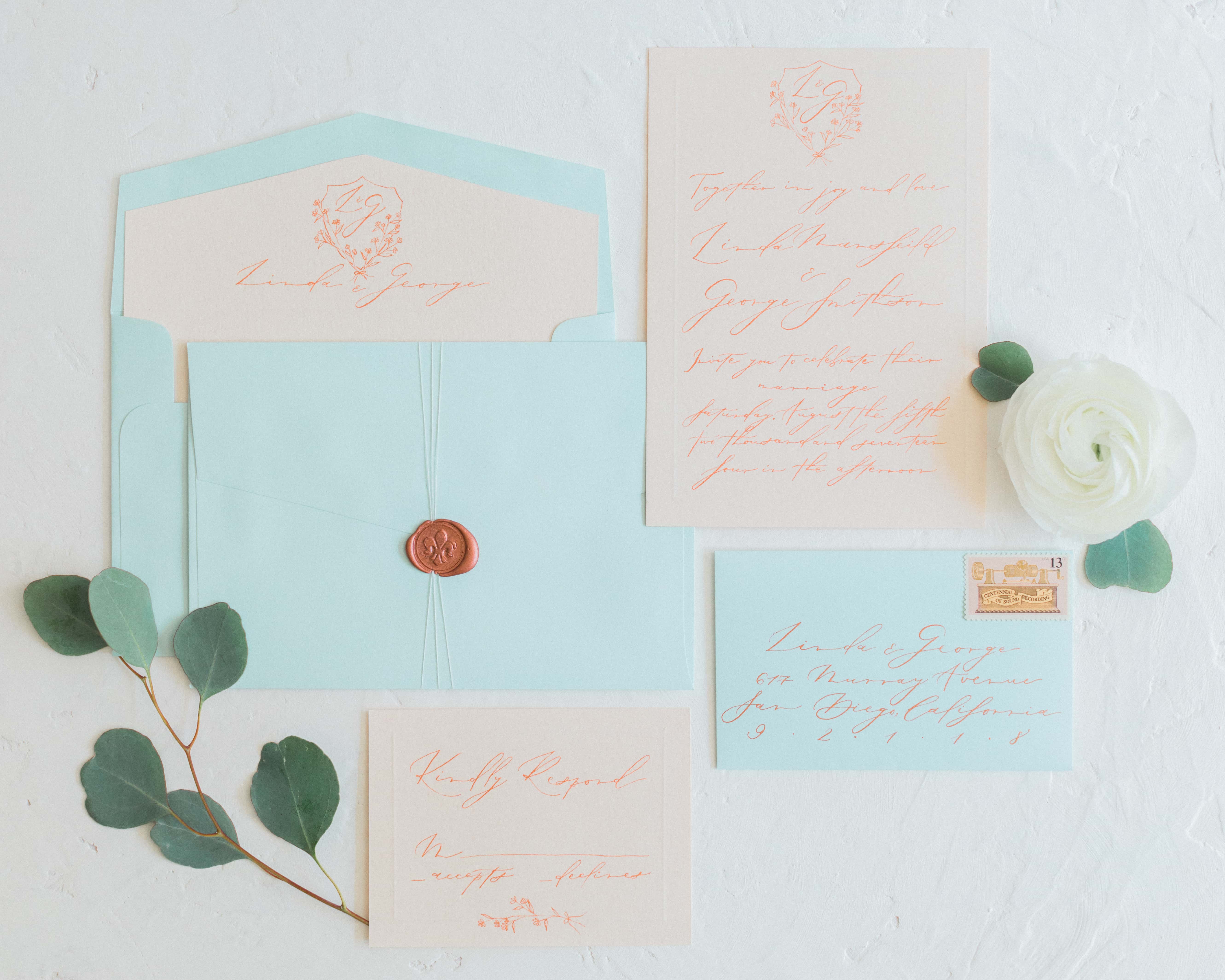
photo by Madeleine Collins Photography (www.bookmcphotography.com)
Tess, Little Duck Calligraphy
www.littleduckcalligraphy.com | @littleduckcalligraphy
Holly is completely right in her statement that we are in the service based rather than product based industry; in designing custom stationery we spend hours talking with our clients and guiding them through the process of stationery design to create their dream suite. It needs to be worth your time to create the things you are doing – we all love what we do and you have to have passion to be in this industry but we have bills to pay!
I always feel a little anxious when I send off a quote as I have found that our type of custom stationery comes with sticker shock for many of our potential clients. The best way to mitigate that sticker shock is to educate the client while communicating with them and when delivering the quote. The most common scenario I have, and many other calligraphers have, is I send out a quote and then just never hear from the client again – I always tried to emphasize that I am quoting for what they have asked for but if it does not work within their budget that I am able to make alternative suggestions but that seemed to fall on deaf ears. So I came up with a new plan by sending a two or three part quote – which sounds excessive but I have had such great success with it (remember it is all about educating the client on the value of what they are asking for). In this multi part quote I give them the price of exactly what they are asking for (usually handmade paper, letter press and silk ribbon), then I do one or two based on what their budget is where I make suggestions for alternatives. These multi part invoices allow the clients to see which of their choices impact the cost of their stationery and in what way. They can either go with one of the quotes or decide to mix between them – for example they may decide that they absolutely want handmade paper but cannot afford it for the whole suite they may decide to use the invitation card from the top tier quote and combine it with the more reasonable quote. Granted, this method of quoting does take a long time and a lot of effort but I have found it results in far more inquiries turning into bookings than my previous method of quoting for exactly what they wanted and saying I could suggest alternative should that not be within their budget.
For certain things like place cards and envelopes I have a set price, but for items that can involve varying amounts of time commitment to the project I work out a custom quote. When working out the amount for each quote there are a number of things I take into consideration – how much time the actual design will take to do, spot calligraphy on a simple invite is very different to hand drawn baroque scrolls with full calligraphy, whether I will be sourcing the paper or it will be supplied by the printer, increased digitizing time if the client wants letterpress as the design then needs to be in a vector format, how much “preparation” needs to go into the accessories and the time I spend emailing and talking with the client to get their design perfect. Already build into how I cost those elements is the time I have spent gaining my knowledge and perfecting my skills – remember your clients are paying not just for the product but also for your expertise in the field. My quotes are done per item with the printing, materials and design cost built into the one cost (this saves the client picking apart my design fees and questioning them). As the design fee is divided between the number of suites the clients are ordering the fewer suites there are the higher the per item cost will be (this sliding scale also reflects that the printer I use charges less once you get to 50 pieces and then 100 pieces and so forth). My design fees start at $400 for an invitation card and increase as the work involved increases. So an invitation with spot calligraphy and a simple or single illustration, flat printed on handmade paper would cost $610 for 100 pieces at $6.10 per invitation while 50 would be $520 at $10.40 an invitation. This difference is due to the same $400 design fee being divided between significantly more pieces in the first example. I do not reduce my design fee when I am working on fewer pieces as it takes me the same amount of time to design for 100 invitations as it does for 50 invitations. For things like invitation addressing there is a standard $3.50 per envelope fee – there is no reduction to this for larger orders as each is done by hand and doing more does not make the process for each any less time consuming. And I use a similar reasoning for “miscellaneous” pricing like ribbons, vellum wraps, wax seals and assembly. When quoting for accessories my quote includes the cost of the item plus my time in making it client ready for them to use. For example vellum would be priced at the cost of the vellum plus $1 for every sheet as I have to cut and fold them ready for the client to simply place around their invitations, ribbon is priced at the cost of the ribbon plus $0.50c to cut them to length for the client. The basic principle is if you would have to pay for these jobs to be done for you then you should be paid to do them for a client. Assembly is priced between $1.00-$1.50 depending on how intricate the assembly is but all of the elements for that assembly have already been priced to be “made ready” for it. So a quote (and later an invoice) would look like this:
[table id=1 /]
And they would receive this and a quote that used standard paper stock as the basis for example.
I feel that many calligraphers and custom stationers are hesitant to fully charge for their time and expertise, especially when they are new to the market and feel that they are not justified in charging those prices. But it is important for yourself for your time to be valued and it is important for the industry for your pricing to be fair. The biggest discrepancy would come from the design part of your fees and for things like addressing envelopes (as the printing and material costs we have to cover would all pretty much be on par). And yes it is reasonable to charge less for those when you are a beginner and then scale upwards as you grow but that “less” should still make it worth your time to be doing and should be within line with the industry. On the pricing survey Holly shared in the last blog there is a range included for many of the states and on the nationwide section for most items for example calligraphers nationwide charge between $2 and $7 as their base envelope price (before extras for centering and metallic ink) – if you are a beginner start on the lower end of that scale maybe (although I think $2 is very low for anybody, remember the survey is from 2016) and gradually increase your prices as you grow and gain a name for yourself, this applies to everything you price for from place cards to invitation design – don’t price yourself too low and never work for a client for the cost of printing and materials to “gain experience”.
[hr]
Cami, Cami Monet Watercolor & Calligraphy
www.camimonet.com | @camimonet
Confession time: I once charged $30 for a logo that took me days to complete. I’ve knocked off a zero on an invoice before sending it to a client. And yep, I’ve lost money on a job. (Womp womp.) But because of those mistakes, I’ve been able to tweak my pricing to actually make a living for myself and not resent my clients. (Don’t act like you haven’t been there!) And let me tell ya, it’s so easy to get hung up on numbers/math/analytics/ starting out, but let go of all the noise and pick a number. Go ahead and pick one that makes you uncomfortable. Odds are you probably didn’t get it right the first time, but don’t let the fear of messing up hold you back. Set a price. Own it. Get paid. And adjust as necessary. (And trust me, there will be adjusting.)
My biggest lesson learned while tweaking my pricing structure? (Because I learned REAL QUICK that my number I picked was off target.) Don’t price by time, price by VALUE. (I know we all love hearing the “what’s your hourly rate??” question, but throw that out the window for a minute here.) Pricing by value instead of by time emphasizes quality and benefits, not quantity or speed and allows you to scale your income. (Cha-ching!) After all, we’re not laborers working for an hourly wage and clocking in at the door. The type of labor we do is different. It’s creative, it’s often non-quantitative, and it’s one of a kind. We’re being hired for the ideas, not just the hours it takes to paint the thing or calligraph the words. You’re charging for the emails, the creative process, the problem solving, the setup, the packaging time, the delivery, etc. You are the expert. So charge like one. After all, why should you be paid LESS for completing a project faster? I currently charge $225 for my pet portraits, and I can finish them in one hour. This doesn’t mean I’m telling my client that my hourly rate is $225; it means I’m honing in on that value-aspect of my work and all the years of practice and expertise I’ve gained along the way! The price your clients are willing to pay is about how valuable the piece is to them, not necessarily the time it costs you to create it. (Of course, don’t forget to cover your costs too!)
So when it comes to my pricing structure, I’m thinking in terms of value, but I’m also mindful of my time spent on a project and those pesky things like overhead costs and taxes, without getting hung up on the constraints of an hourly rate. I multiply my wholesale paper and printing costs by three to cover for shipping charges, extra pieces or fees that I might not have anticipated, and then I’m adding my design fee on top of that. For example, I offer watercolor signature drink signs printed on canvases (and holy moly, y’all they are SO cute. Yes, I’m obviously biased.) The smallest canvases start at $325, so let’s break down how I got to that price: the printing cost of the canvas is $35 so I multiply that by 3 to get my retail price of $105. And from there, I’m adding on my design fee of $220 that includes one drink illustration and spot calligraphy (additional illustrations obviously bring up that price!), and presenting it to the client as $325 total, plus shipping and sales tax if warranted. Okay enough business, business, numbers. The ticket here is the way I’m presenting this to client. The benefits of having a one-of-a-kind, completely unique wedding detail that makes perfect kitchen decor is what I’m really selling. Sell the value in the end result and you’ll never have to market anything else a day in your life. (Or calculate an hourly rate!)
My price-raising tip: Think about how to add “free” value to your product, whether it’s upping that perception of luxury, offering a client experience that knocks their socks off, or carving out a niche that only you can fill. Your work has value, and your dreamiest clients will pay you for it.
[hr]
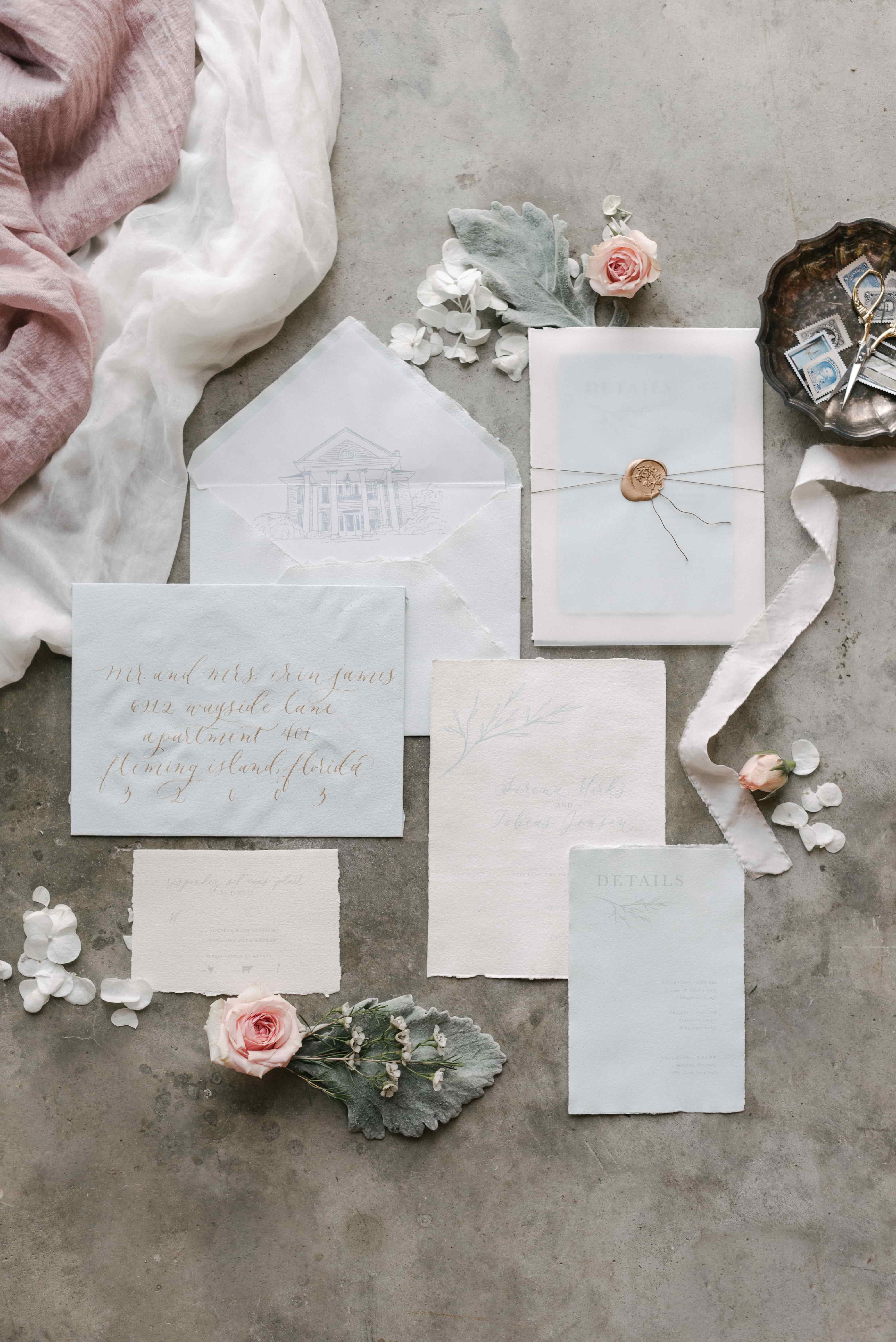
photo by Tonya Volk Photography
Sarah, Sarah B. Calligraphy
sarahbcalligraphy.com | @sarahbcalligraphy
I get asked about what my pricing structure for wedding invitations is frequently. This is by no means perfect for everyone, but it works for my clients and me. I think it’s important to try something different to see what works best for you. For my stationery clients, I have a design fee and a printing fee. The design fee acts as my non-refundable retainer and includes a consultation, mood board, unlimited sketches, up to 3-5 final proofs (depending on package), complimentary envelopes and standard shipping, assembly, and return address design. I don’t want my clients—or me—to worry about extra fees, such as envelopes and shipping. The invitation suite is the major focus, and I want to keep it that way. Plus, who doesn’t love complimentary products and services!? These complimentary products aren’t something that break the bank for me, and I know my printing fees will make up for any loss in revenue.
I outsource almost all of my printing from note cards to invitations because during that time, I can address the envelopes or create other things for my clients. If the project involves handmade paper or is a small digitally printed invitation batch, I will print in-house. I have wholesale accounts with my printers, so it’s similar to being a retailer who doubles or triples the printing fees, depending on the method. This helps compensate the shipping fee and the time it takes communicating with the printer.
I used to have a $250 design fee. I know, I know… I was undercharging myself! That’s when I had to break down what I was actually getting from a 20+ hour job. Let’s say it took 25 hours to complete the job and I made $400 from the printing difference and design fee. That’s $16 per hour. If my goal is to make $2000 per month, I would have to book five wedding invitation clients. This isn’t realistic for most people, especially if you want to give your clients the best experience and you also work alone. You don’t want to rely on having to book five clients each month, which can be difficult when you’re starting out. Not only does the chance for mistakes increase, but also the stress of overlapping clients can weigh you down. Which sounds better: possibly $400 profit or a guaranteed $850-1200 profit? I have two packages where $850 is the classic suite with calligraphy and typography, and the $1200 package includes any and all illustrations. These prices are dependent on how long I’ve been a graphic designer and my skill level, so someone just starting out wouldn’t necessarily have the same pricing.
I’ve learned in the past year just how valuable my time is. I want to get paid for the value of work I produce and the client experience I provide. Being able to have the option of having one or two wedding stationery clients—instead of five—definitely makes me feel better about giving the best to my clients! It all boils down to what profit you need to make, how long it’ll take, and what your skill level is. Try working backwards from the monthly profit and see how many clients you can take on. This is all circumstantial, so you may can have one client every 2 months, but compensate with passive income from products from your shop. I decided I’d rather have one invitation suite client for approximately $2000 than sell 200 prints for $10 each. This is a personal choice for me, so I advise that you try what you enjoy and works best for you! If you need other information or have questions, you can visit my Facebook group Becoming a Wedding Stationery Boss or have a one-on-one consultation. I love the topic of pricing, and I think our industry needs more insight and transparency. I strive to provide that and am so glad Holly is starting this discussion!
[hr]
So…what did you think?
Are you feeling a little bit better about pricing your work? I’m sure you still have questions – because all of us do when we’re faced with something new! – but do you feel more confident about pricing your own work now? I hope so!
Sharing pricing isn’t the same as sharing trade secrets. It may feel that way at first, because we’ve been conditioned to believe that sharing our pricing with anyone (including clients who haven’t been vetted yet) somehow makes us vulnerable. I’m still not sure why we feel vulnerable; perhaps we fear rejection from prices that are”too high” for clients or “too low” for our peers.
Either way, pricing details are hard to share. It takes a bit of courage and a lot of thought and practice to back up your numbers. So I don’t know about you, but I’m giving Dominique, Tess, Cami, and Sarah a HUGE round of applause for sharing their tips and tricks to pricing with you all!
Dominique of Plume and Fête | @plumeandfete
Tess of Little Duck Calligraphy | @littleduckcalligraphy
Cami of Cami Monet Watercolor & Calligraphy | @camimonet
Sarah of Sarah B. Calligraphy | @sarahbcalligraphy
Thank you all for joining me! Tune in next time for a surprise (If you liked this post, I think you’ll love it!).
Did you miss Part I and Part II of the series? Click the links to check them out!
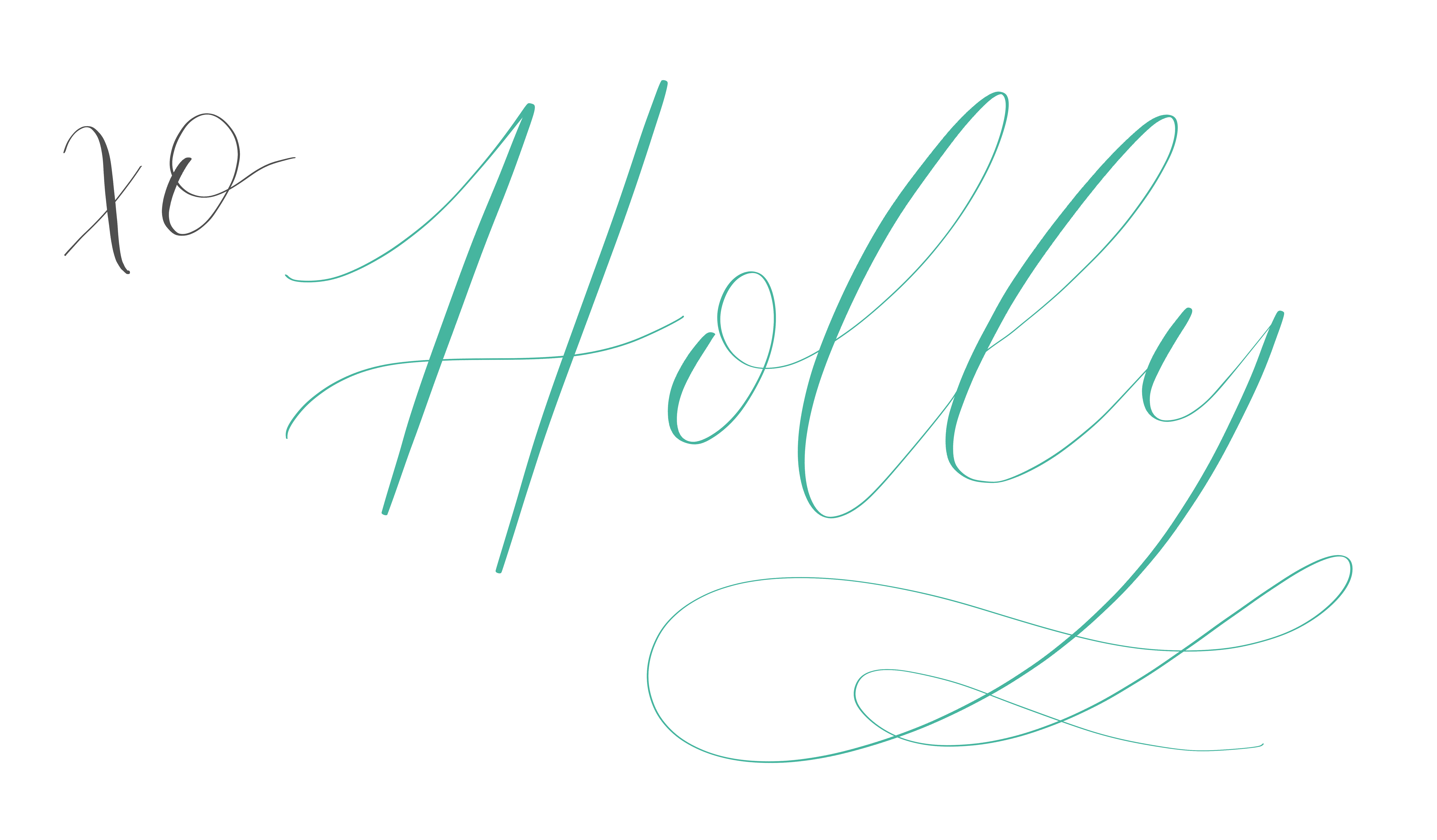
[hr]
Don’t miss out on Part IV coming next week!
Shhh…it has surprise material. To be notified when it goes live, sign up below!
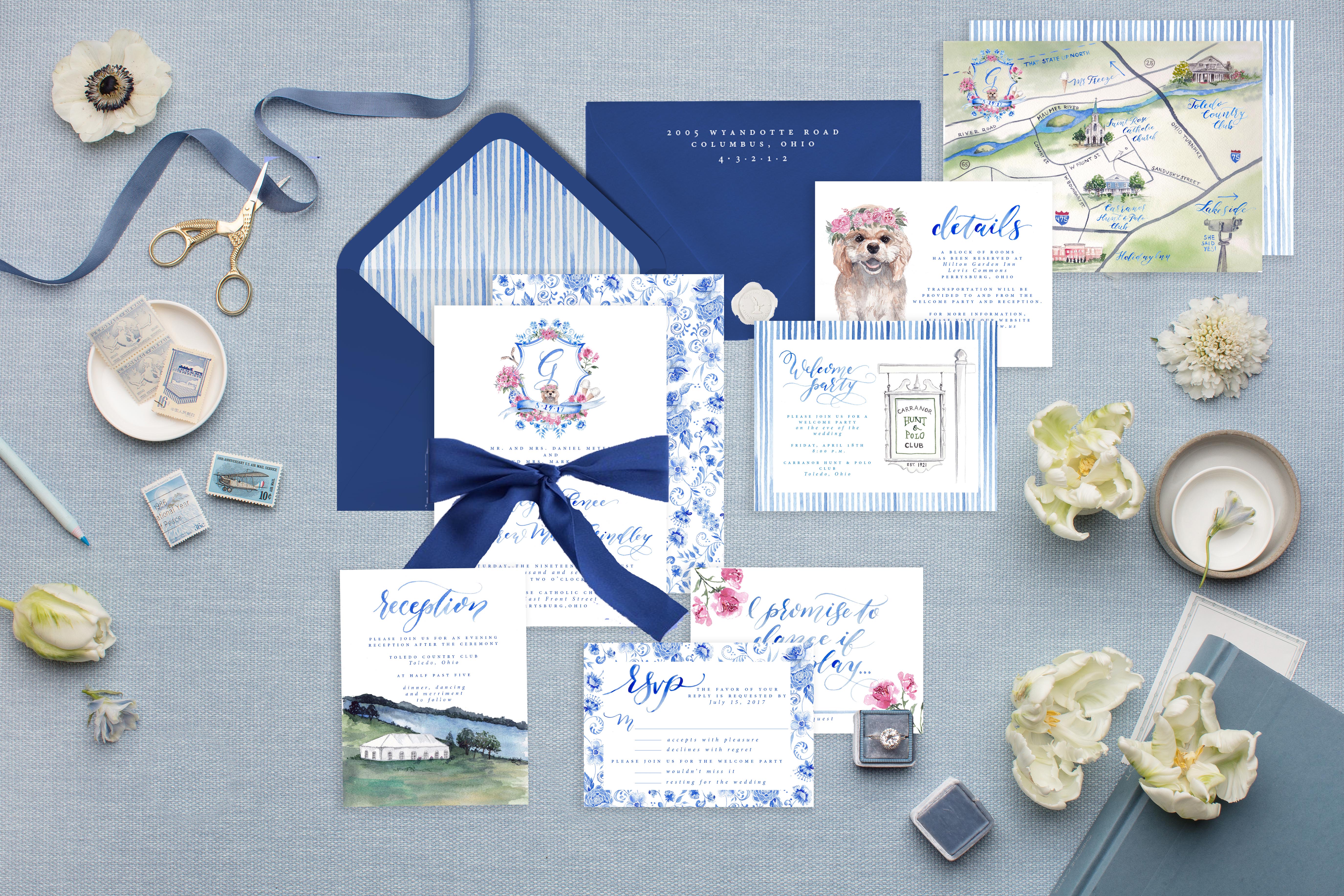
This is such a valuable resource. For me personally I find the ‘business’ side of my business doesn’t come naturally; anything to do with numbers (I’m looking at you Excel) brings me out in a cold sweat.
Thanks Holly, and to all the ladies for sharing their experiences and advice and helping to demystify pricing. Feeling very inspired!x
Thank you so much, Rose! I totally understand where you’re coming from! As creatives, I think that this side of the business is definitely one of the harder tasks we face on a daily basis. Hopefully all of the advice here has helped give you some insight into pricing and the struggles that everyone faces with pricing – you’re definitely not alone! 🙂
[…] that sounds like you, I have some great news! After the Pricing Taboo, Part III went live, Jian (a fellow calligrapher and stationer) reached out and introduced me to an AMAZING […]